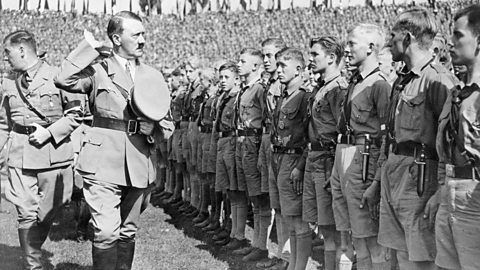The creation of the Police State
By August 1934, Hitler was a dictatorA ruler with total power over a country, who has generally come into power through force. Dictators usually rule in a cruel and brutal way. in Germany.
He used a wide variety of methods to maintain this.
Hitler and the Nazis created a Police State to exercise control over the population.
There were three main parts to it:
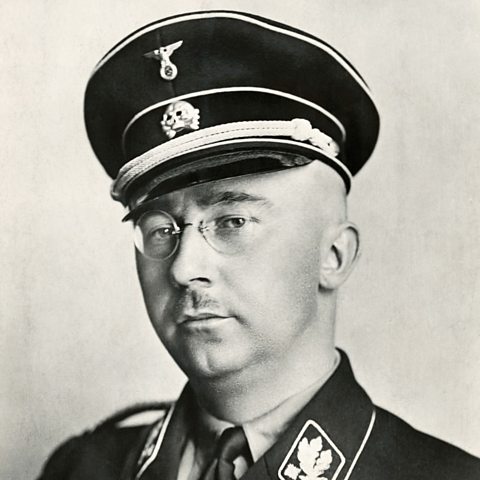
The Schutzstaffel SSThe Schutzstaffel, also known as the Blackshirts. A police/military style organisation created to serve as Hitlerâs personal bodyguard. In Hitler's Germany they eventually controlled the intelligence, security and police forces, and the extermination of those they considered undesirable. was led by Heinrich Himmler and was the most important of the three organisations. It oversaw the others. By 1935, it numbered 200,000. Its leaders became more important than the Party organisation in running the country. The SS set up concentration camps where âenemies of the stateâ were sent.
The Gestapo was the Nazisâ secret police force. In 1934, Himmler replaced Hermann Göring as its leader. Its job was to monitor the German population for signs of opposition or resistance to Nazi rule and eliminate it. Although its membership was not huge, it was greatly feared because it was so powerful. The Gestapo listened to telephone calls, intercepted letters and encouraged ordinary Germans to inform on their fellow citizens.
The SicherheitsdienstThe intelligence agency of the Nazi Party in Nazi Germany. Also known as SD or Security Service. (SD) was the intelligence-gathering agency of the SS. It was responsible for the security of Hitler and other top Nazis and was led by Himmlerâs right-hand man, Reinhard Heydrich.

The legal system
The Nazis swept away many of the freedoms that Germans had previously enjoyed:
- Judges had to swear an oath of loyalty to Hitler and were expected always to act in the interests of the Nazi state.
- The role of defence lawyers in criminal trials was weakened.
- All lawyers had to join the Nazi Lawyers' Association, which meant they could be controlled.
- Standard punishments for crime were abolished, so local prosecutors could decide what the punishment should be.
- Peopleâs Courts were set up in 1934 to try those accused of âcrimes against the stateâ.
- Protective custody was introduced for those who might commit a crime. This meant people could be arrested and internedImprisoned without trial. even if they had not broken the law.
- The number of crimes that carried the death penalty increased from three to 46.
These changes meant the legal system was no longer fair.
People lost many of their civil rights Rights everyone is entitled to regardless of the colour of their skin, their beliefs, sexuality, sex or other personal characteristics. These rights could include - amongst other things - the right to vote, the right to free speech or the right to a good education..
Concentration camps
In 1933, Dachau was the first camp to be opened.
By 1939, there were six.
They were run by the Deathâs Head Unit of the SSThe Schutzstaffel, also known as the Blackshirts. A police/military style organisation created to serve as Hitlerâs personal bodyguard. In Hitler's Germany they eventually controlled the intelligence, security and police forces, and the extermination of those they considered undesirable..
A wide variety of people were sent to the camps.
- Many convicted criminals were not released at the end of their prison sentences but were instead moved to the concentration camps.
- Political opponents, like communistSomeone who believes in the political ideology of communism, a system of running a country in which all means of production such as tools, factories and raw materials, are owned by the community as a whole. Private property does not exist and each individual contributes according to their ability and receives according to their needs. This means there is no hierarchy of social class., as well as Jews, ministers and priests were also sent there.
- People regarded by the Nazis as âasocialâ also ended up in these camps. Nazis classified the âwork-shy", prostitutes and homosexuals as âasocialâ.
Impact of the Police State
The Police State had a big impact on all aspects of peopleâs lives and was very successful in its aims.
- It meant there was little opposition to the Nazis. Most people complied with regulations. They became fearful of being arrested for no reason.
- Society became more suspicious and tense. Some people publicly criticised or informed on their neighbours to make themselves look more loyal. Children were encouraged to report on their parents and teachers.
- Justice disappeared. Many did not receive fair trials because of changes to the law.
- The number of criminal offences committed was halved by 1939, but the number of people in prison increased. By 1939, there were over 600,000 in prisons or concentration camps. Many innocent people were detained as âenemies of the stateâ.
Propaganda and censorship
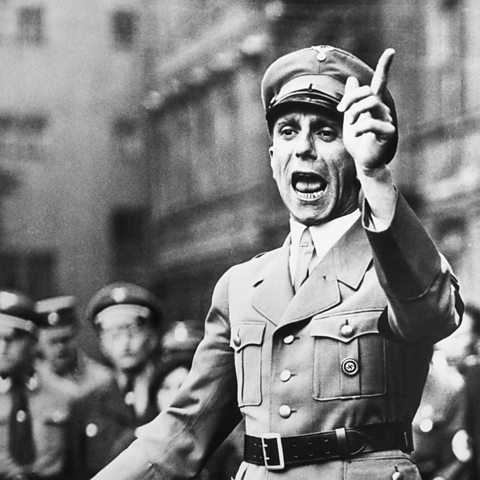
Dr Joseph Goebbels was the Nazi in charge of propaganda throughout Germany and was given the title of Minister for Popular Enlightenment and Propaganda.
He believed propaganda worked best if it were âinvisibleâ (ie subtle) and âall-pervasiveâ (ie everywhere).
The government department responsible for propaganda was the Ministry of Enlightenment and Propaganda.
All aspects of the media, culture and the arts were censored and used for Nazi propaganda by this department.
Much of the information Germans received reinforced the message of AryanA person of European descent - not Jewish - often with blond hair and blue eyes. The Nazis viewed Aryans as the superior human race. racial superiority whilst bitterly bad-mouthing the Jews and other âenemiesâ of the regime.

Question
What was the aim of propaganda and censorship?
The aim of propaganda and censorship was to brainwash people into obeying the Nazis and idolising Hitler.
It was achieved by ensuring only the ideas and values of the Nazis were heard and seen by the masses.
Censorship of the press
- Newspapers could only print stories favourable to and approved by the Nazis.
- Daily briefings were held for editors to tell them what to print and where to place articles in their newspapers.
- Editors had to join the Nazi Party or be dismissed.
- All radio output was controlled by Goebbelsâ Ministry through the Reich Broadcasting Corporation.
- Listening to foreign stations was banned.
- Nine million radios were sold cheaply so that most Germans could afford one and thus be indoctrinatedTaught to believe certain ideas/things without question.. These âPeopleâs Receiversâ could only be tuned to the Nazi station. By 1939, 70 per cent of households owned one of them.
Large public events
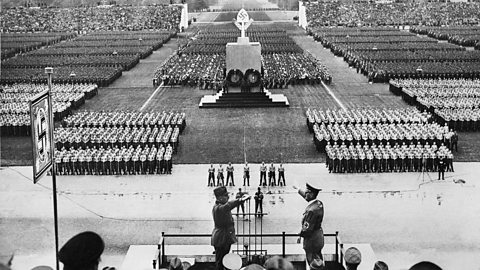
There were mass rallies to show public support for Nazism which involved music, speeches and demonstrations of German military strength. The biggest rally was the annual Nuremberg Rally held in August. It lasted a week and was characterised by order and discipline, marching, massive displays of flags and symbols and rousing music. Rallies were held at other times in the year as well, for example on Hitlerâs birthday.
Sports events were held to allow people to be either spectators or participants in mass activities. The Strength Through Joy (KdF) movement organised many of these. Berlin hosted the Olympics of 1936, which the Nazis used as an opportunity to showcase the success of the regime and to demonstrate the superiority of the of the "Aryan race". The victories of Jesse Owens, a black athlete from the USA, infuriated the Nazi leadership.
Use of loudspeakers in public places
- Loudspeakers were placed in cafés, town squares and workplaces to blare out Nazi propaganda. Therefore, even those people who did not have a radio did not escape the Nazi message.
Control of culture
The Nazisâ influence on all areas of culture demonstrates the extent to which Hitler sought to control German life and win over the people to Nazism.
Various forms of culture in Germany were heavily censored.
Art and architecture
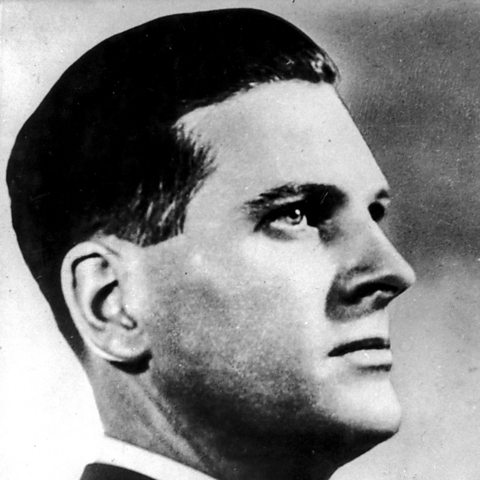
Hitler saw modern art, such as abstract art, as âdegenerateâ and over 6,500 works of art were removed from display across Germany.
Hitler was very interested in architecture and believed it could be used to project the power of the Nazi regime.
He favoured two types - classical architecture A similar style of building as constructed by the ancient Greeks or Romans. for public buildings, and rural-style architecture The type of buildings found in country (rural) areas. for other buildings.
The most important architect of the period was Albert Speer, who redesigned Berlin as well as designing the main stadium in Nuremberg where the annual rallies were held.

Literature
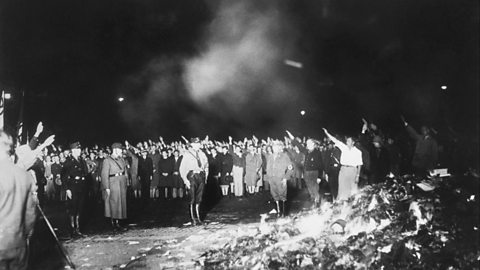
There was massive censorship of literature.
The Nazis drew up a list of over 2,500 banned authors and encouraged the burning of books that challenged Nazi ideas and values.
In 1933, 20,000 unacceptable books were destroyed at the University of Berlin.
These included books written by Jews, pacifists and communistSomeone who believes in the political ideology of communism, a system of running a country in which all means of production such as tools, factories and raw materials, are owned by the community as a whole. Private property does not exist and each individual contributes according to their ability and receives according to their needs. This means there is no hierarchy of social class..

Film
All film plots were shown to Goebbels for approval before production.
The most common themes were German greatness and anti-semitismHostility or prejudice against Jews., eg The Eternal Jew.
Nazi propaganda was shown before feature films and many American films were banned.
Music
Goebbels drew up lists of what was acceptable.
Jewish composers, such as Mendelssohn and Mahler, were banned and the works of the German composer Wagner were promoted and gained huge popularity.
They also promoted folk songs and marching music.
The Nazis were strongly opposed to jazz music, seeing it as 'degenerate'.
The impact of propaganda and censorship on the German people
Successes
- Propaganda helped reinforce existing beliefs.
- Mein KampfHitlerâs autobiography, written in 1925. became a best seller because people thought it was wise to display their loyalty.
- The scale of the propaganda campaigns meant Hitler and the Nazi Party were a constant presence in peopleâs lives.
- Weekly Nazi newsreels, shown in cinemas before films, and loudspeakers in cafés and workplaces meant the Nazi message could not be avoided.
Failures
- Propaganda was less successful at getting people to accept new ideas.
- The quality of much culture was also poor. The range of music, films and books was very restricted.
- Some musicians, artists, actors and writers left Germany. Although, others joined the Nazisâ cultural organisations.
Opposition in Nazi Germany
It is difficult to know exactly how much support there was in Germany for the Nazi regime.
It is generally acknowledged that it was widely accepted, even if it was not always popular.
This lack of open opposition was because:
- The Police State created fear.
- Many of Hitlerâs political rivals were in exile, prison or hiding.
- It was difficult for organisations to co-ordinate opposition.
- The massive scale of indoctrination and censorship convinced many of Hitlerâs "greatness" and concealed any problems.
- Many Germans liked Hitlerâs decisive leadership after the weakness of the Weimar politicians.
- The Nazis had some popular achievements, such as full employment, disciplined youth and the Strength Through Joy (KdF)A Nazi organisation set up to organise leisure activities. .
- Hitler restored national pride.
However, there was some opposition. This was in the form of:
- A great deal of private grumbling.
- passive resistanceTo peacefully oppose something. and refusing to co-operate with regulations, including not joining the Nazi Party, reading banned books, listening to forbidden music and not using the Heil Hitler salute.
- Open defiance of the regime, for example by some church leaders and a number of youth groups.
Opposition from the churches
Hitler hated all religion.
At first, Hitler tried to get the churches to encourage their members to support the Nazis, however this proved to be difficult.
The Protestant church
The Protestant Church was divided in its opinion of the Nazis.
Pro Nazis
- Formed the German Christians/Reich Church.
- Led by Ludwig Muller.
- They adopted Nazi-style uniforms, salutes and marches.
- Their slogan was âThe Swastika on our breasts and the cross in our heartsâ.
- Any ânon-Aryanâ ministers were dismissed.
Anti-Nazis
- Set up the Confessional Church which criticised the Nazi regime and German Christians.
- Led by Pastor Martin Niemoller who was sent to Dachau concentration camp.
The German Faith Movement
- The Nazis established their own church, The German Faith Movement, in 1934.
- This was based on paganAn ancient religion that involves worshipping the natural world and more than one God. beliefs and had few members.
It is believed that Hitler may have tried to replace Christianity with this movement.
The Catholic church
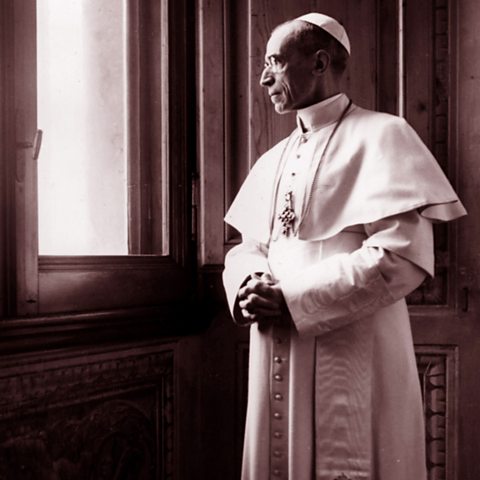
Initially, the Concordat (an agreement signed with the Vatican in July 1933) appeared to work satisfactorily.
The Church stayed out of politics in return for the Nazis letting its religious services, youth groups and schools continue to operate.
However, as time passed some Catholics opposed Hitler because he broke the Concordatâs terms.
The Nazis campaigned to stop children attending Catholic schools, they ended the Catholic youth movement and they harassed priests.
The Catholic church also opposed Hitler because of growing censorship and the persecution of the Jews, and later its policy ofeuthanasiaThe deliberate ending of someoneâs life..
In 1937, a letter from Pope Pius XII attacking Hitler as 'a mad prophet with repulsive arrogance' was read in every Catholic Church.
A number of priests were imprisoned for doing this.
In all, 400 German Catholic priests were imprisoned in Dachau concentration camp.
Although individual clerics opposed the regime, most remained quiet.
They did not speak out more vocally because they feared Hitler would eliminate religion completely if there were stronger protests from the churches.
Overall, the Nazis had some successes in trying to undermine the influence of the Protestant and Catholic Churches and limit their criticism of Hitler, but they never eliminated religionâs influence.

Opposition from young people
In 1933, Hitler YouthNazi organisation set up to convert Germanyâs young people to Nazism. took over all youth movements in Germany, except Catholic ones (which were eliminated in 1936).
Not all young people became part of the Hitler Youth movement. A significant minority managed to avoid joining.
Some even established rival youth groups.
The Edelweiss Pirates
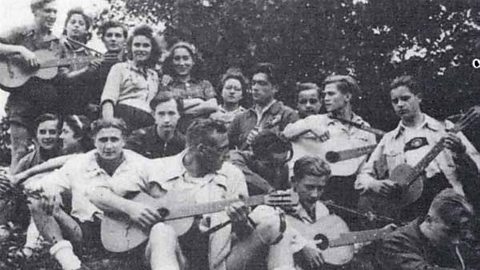
The main working class youth group which opposed Hitler was the Edelweiss Pirates.
Members reacted to the discipline of the Hitler Youth by daubing anti-Nazi slogans and singing pre-1933 folk songs.
Their main activity was camping trips to the countryside to get away from the stifling control of the Nazis.
In 1942, over 700 of them were arrested. In 1944, the Pirates in Cologne killed the GestapoThe Nazisâ secret police force. chief, so the Nazis publicly hanged 13 of them.

The White Rose
The White Rose group was formed by students at Munich University in 1943.
They published anti-Nazi leaflets, distributed posters, wrote anti-Nazi graffiti and marched through the city in protest at Hitlerâs policies.
Its leaders, brother and sister Hans and Sophie Scholl, were arrested and sentenced to death.
Swing Youth and Jazz Youth
The Swing Youth and Jazz Youth groups were mainly upper middle class young people who rejected Nazi values as well as having the money to visit night clubs.
They danced the jitterbugA dance made popular by black Americans. to banned jazz music.
They were closely monitored by the Gestapo, who regularly raided illegal jazz clubs.
Test your knowledge
More on Life in Nazi Germany, 1933-45
Find out more by working through a topic
- count3 of 7
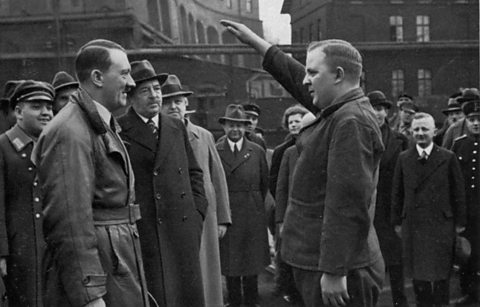
- count5 of 7
